铁锰硅镍铝高熵合金的低温变形强化机制
IF 8.3
1区 材料科学
Q1 MATERIALS SCIENCE, MULTIDISCIPLINARY
引用次数: 0
摘要
系统研究了一种新开发的无钴铁锰硅铝高熵合金(HEA)在室温和低温下的力学性能和变形机制。室温下的初始拉伸变形以位错滑移为主,变形诱导的 FCC → HCP 马氏体转变所产生的转变诱导塑性(TRIP)效应带来了适度的强化。随后,在变形的中后期,TRIP 效应明显增强,使屈服强度(σy,315.1 兆帕)、极限抗拉强度(σu,773.4 兆帕)和断裂伸长率(εf,78.3%)达到极佳的组合。在低温条件下,由于 FCC → HCP 马氏体转变的增强,TRIP 效应的强化作用显著增强。这导致了在 223 K 时强度和延展性的协同改善,σy 为 363.6 MPa,σu 为 832.1 MPa,εf 为 87.2%。223 K 时延展性的增强与变形中后期的 FCC → HCP → BCC 顺序马氏体转变有关,它是容纳塑性应变和延迟应变局部化的另一种方法。然而,在 173 K 和 77 K 的变形早期阶段,FCC → HCP 的快速转变阻碍了后续变形阶段的 FCC → HCP → BCC 顺序马氏体转变,从而显著提高了强度,但降低了延展性。我们的研究结果为设计和开发用于低温应用的 TRIP 辅助单相 FCC HEA 提供了新的思路。本文章由计算机程序翻译,如有差异,请以英文原文为准。

Cryogenic deformation strengthening mechanisms in FeMnSiNiAl high-entropy alloys
The mechanical properties and deformation mechanisms of a newly developed Co-free FeMnSiNiAl high entropy alloy (HEA) at room and cryogenic temperatures were systematically investigated. The initial tensile deformation at room temperature was dominated by dislocation slipping, with modest strengthening from the Transformation-Induced Plasticity (TRIP) effect due to the deformation-induced FCC → HCP martensitic transformation. Subsequently, the TRIP effect was markedly enhanced during the middle and later stages of deformation, leading to an excellent combination of yield strength (σy, 315.1 MPa), ultimate tensile strength (σu, 773.4 MPa), and fracture elongations (εf, 78.3 %). The strengthening by the TRIP effect was significantly enhanced at cryogenic temperatures as a result of enhanced FCC → HCP martensitic transformation. This resulted in a synergetic improvement in strength and ductility at 223 K, with σy of 363.6 MPa, σu of 832.1 MPa, and εf of 87.2 %. The enhanced ductility at 223 K was linked to the FCC → HCP → BCC sequential martensitic transformation during the middle and later stages of deformation, which acted as an additional way to accommodate plastic strain and delay strain localization. However, the rapid FCC → HCP transformation at the early stage of deformation at 173 K and 77 K impeded the FCC → HCP → BCC sequential martensitic transformation during subsequent deformation stages, thus remarkably enhancing strength but reducing ductility. Our findings provide new insights into the design and development of TRIP-assisted single-phase FCC HEAs for cryogenic applications.
求助全文
通过发布文献求助,成功后即可免费获取论文全文。
去求助
来源期刊

Acta Materialia
工程技术-材料科学:综合
CiteScore
16.10
自引率
8.50%
发文量
801
审稿时长
53 days
期刊介绍:
Acta Materialia serves as a platform for publishing full-length, original papers and commissioned overviews that contribute to a profound understanding of the correlation between the processing, structure, and properties of inorganic materials. The journal seeks papers with high impact potential or those that significantly propel the field forward. The scope includes the atomic and molecular arrangements, chemical and electronic structures, and microstructure of materials, focusing on their mechanical or functional behavior across all length scales, including nanostructures.
 求助内容:
求助内容: 应助结果提醒方式:
应助结果提醒方式:


